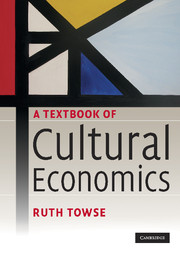Book contents
- Frontmatter
- Contents
- List of figures
- List of tables
- List of boxes
- List of abbreviations
- Preface
- Part I General issues in cultural economics
- Part II The ‘traditional’ economics of the arts and heritage
- Part III Artists' labour markets and copyright
- Introduction
- 11 Economics of artists' labour markets: theories
- 12 Economics of artists' labour markets: empirical research
- 13 Economics of copyright
- Part IV The creative industries
- Part V Conclusion and exercises and problems
- References
- Index
12 - Economics of artists' labour markets: empirical research
- Frontmatter
- Contents
- List of figures
- List of tables
- List of boxes
- List of abbreviations
- Preface
- Part I General issues in cultural economics
- Part II The ‘traditional’ economics of the arts and heritage
- Part III Artists' labour markets and copyright
- Introduction
- 11 Economics of artists' labour markets: theories
- 12 Economics of artists' labour markets: empirical research
- 13 Economics of copyright
- Part IV The creative industries
- Part V Conclusion and exercises and problems
- References
- Index
Summary
Interest in the facts about artists' incomes and employment began with Baumol and Bowen's analysis of the causes of rising costs in the arts, and empirical research on artists' labour markets therefore became an integral part of testing Baumol's cost disease, with its proposition that it is labour costs that are responsible for rising costs. It seems that Baumol and Bowen themselves were the first researchers to gather data on performers' earnings and employment characteristics in their 1966 book, in which they used US Census Bureau and Bureau of Labor Statistics data. This triggered various types of data collection and analysis of artists' labour market behaviour, which are investigated in this chapter.
Data sources and research methods
In terms of the collection of data, in the United States, the National Endowment for the Arts has regularly published data on incomes, employment and unemployment of a broadly defined set of artists since 1976. In Australia the Australia Council for the Arts published the first of a series of surveys of artists in 1983 and continues to do so in collaboration with David Throsby. The Finnish Arts Council undertook a series of detailed investigations from the late 1980s and through the 1990s into the economic conditions of specific artistic occupations using tax data. Statistics on artists' earnings were collected in France by the Observatoire de l'emploi culturel from the 1980s and in the Netherlands by the Central Bureau of Statistics in the 1980s.
- Type
- Chapter
- Information
- A Textbook of Cultural Economics , pp. 319 - 340Publisher: Cambridge University PressPrint publication year: 2010



